
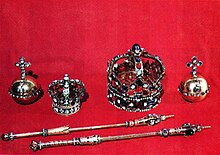
Crown of Maria Josepha was made for Maria Josepha of Austria for her coronation as queen consort of Poland in 1734.


Crown of Maria Josepha was made for Maria Josepha of Austria for her coronation as queen consort of Poland in 1734.
In 1925 the Polish Government bought the silver regalia of King Augustus III and Queen Maria Josepha in Vienna for $35,000 (175 000 zł). It consisted of 2 crowns, 2 sceptres and 2 orbs made in about 1733. The original Crown Regalia were hidden - see War of the Polish Succession. [1] The jewels were exhibited in Warsaw till 1939. In 1940 German forces stole them. [1] Later they were found by Soviet troops in Germany and sent to the USSR, where they stayed until 1960, when they were returned to Poland. [1] Today are deposited in the National Museum in Warsaw. [2]
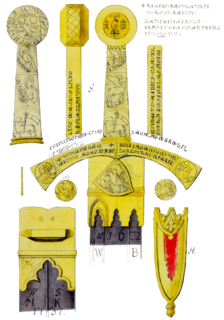
Szczerbiec is the ceremonial sword used in the coronations of most Polish monarchs from 1320 to 1764. It now is displayed in the treasure vault of the royal Wawel Castle in Kraków, as the only preserved part of the medieval Polish crown jewels. The sword is noted for its hilt, decorated with magical formulae, Christian symbols, and floral patterns, as well as for the narrow slit in the blade which holds a small shield with the coat of arms of Poland. The name of the sword, derived from the Polish word szczerba, may be rendered into English as "the Notched Sword" or "the Jagged Sword", though the edges of its blade are straight and smooth.
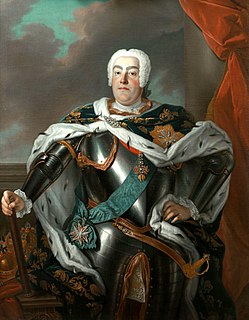
Augustus III was King of Poland and Grand Duke of Lithuania from 1733 until 1763, as well as Elector of Saxony in the Holy Roman Empire where he was known as Frederick Augustus II.
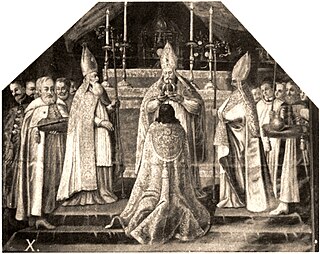
Coronations in Poland officially began in 1025 and continued until 1764, when the final king of an independent Poland, Stanisław August Poniatowski, was crowned at St. John's Cathedral in Warsaw. Most Polish coronations took place at the Wawel Cathedral in Kraków, but crownings also occurred in Poznań and at Gniezno Cathedral. Whenever practical, Polish coronations were conducted as close as possible as to the date of the previous sovereign's funeral. This was explained by Joachim Bielski in the sixteenth century as osoba umiera, korona nie umiera, or "the person dies, the crown dies not". With the emergence of an independent, republican Poland after World War I, coronations in the Polish state have been rendered obsolete.
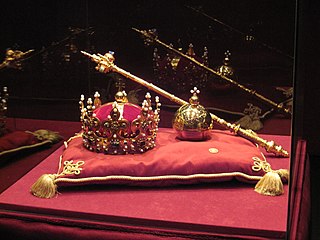
The only surviving original piece of the Polish Crown Jewels from the time of the Piast dynasty is the ceremonial sword – Szczerbiec. It is currently on display along with other preserved royal items at the Wawel Royal Castle Museum in Kraków.
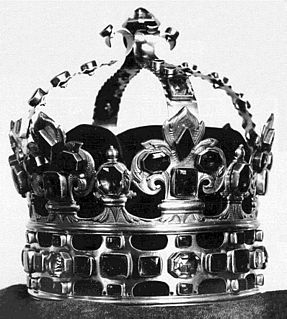
The Crown of Augustus II was intended for his coronation as a King of Poland. The crown was made in 1697 by Freiburg's goldsmith Johann Friedrich Klemm. It was not used, however. The Augustus II's crown is kept in Dresden Armory (Rüstkammer) in Dresden, Germany.

The Crown of Augustus III was made in 1733 for Augustus III's coronation in Kraków in 1734.

Throughout most of the history of Poland, the banner of Poland was one of the main symbols of the Polish State, normally reserved for use by the head of state. Although its design changed with time, it was generally a heraldic banner, i.e., one based directly on the national coat of arms: a crowned White Eagle on a red field. The banner should not be confused with the flag of Poland, a white and red horizontal bicolor, officially adopted in 1919.
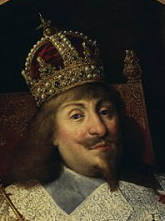
The Swedish Crown, also known as the "Purchased Crown", was a part of the Polish Crown Jewels.
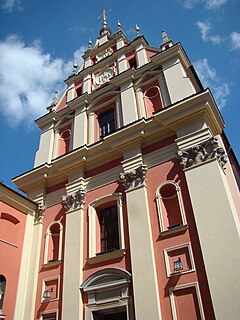
The Jesuit Church, also known as Church of the Gracious Mother of God, is an ornate church within the Old Town precinct in Warsaw, Poland. The temple stands on Świętojańska Street, adjacent to St John's Cathedral, and is one of the most notable mannerist-style churches in Warsaw.

Urszula Meyerin was a politically influential Polish courtier and mistress to King Sigismund III of Poland. Her real surname may have been Gienger, but that remains in dispute; she signed her letters Ursula Meyerin. In the German language, that surname means "chamberlain", "administrator", "manager".

The Grunwald Swords were a mocking "gift" sent by Ulrich von Jungingen, the Grand Master of the Order of Teutonic Knights, to King Władysław II Jagiełło of Poland and Grand Duke Vytautas of Lithuania on 15 July 1410, just before the Battle of Grunwald (Tannenberg). The gift, a pair of simple bare swords, was a symbolic invitation to engage Jungingen's forces in battle. After the Polish–Lithuanian victory, both swords were taken as a war trophy by King Władysław II to Kraków, Poland's capital at the time, and placed in the treasury of the Royal Wawel Castle.
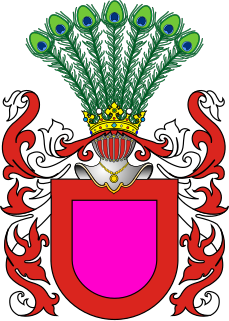
The House of Sobieski was a prominent magnate family of Polish nobility in the 16th and 17th centuries from which the King of Poland and Grand Duke of Lithuania Jan III Sobieski originated. The family used the Janina coat of arms.

The Crown of Bolesław I the Brave was the coronation crown of the Polish monarchs.
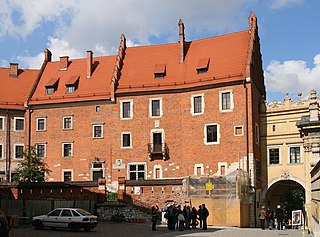
The John Paul II Cathedral Museum is a museum in Kraków, Poland. It is situated on Wawel Hill, between the Vasa Gate and the former seat of the Castle Seminary, in the Cathedral House, which is composed of two 14th-century buildings.
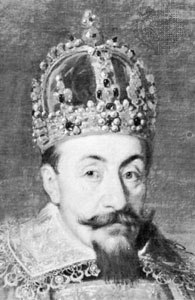
The so-called Muscovy Crown was a part of the Polish Crown Jewels. It was made in about 1610 in anticipation of Prince Władysław Vasa's coronation as Tsar of Russia, which was also known as Muscovy. Due to his father's opposition and a popular uprising in Russia, he never actually took the Russian throne, despite being elected by the Seven Boyars. Nevertheless, until 1634 he used the title of Grand Duke of Muscovy.
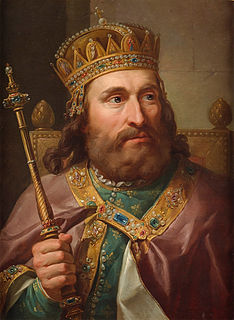
The Hungarian Crown was a part of the Polish Crown Jewels. It was made in the 16th century, resembling the Crown of Saint Stephen, as a private crown of John II Sigismund Zápolya.

The Funeral Crown, also known under its Latin name as the Corona Funebris or Funebralis, was a part of the Polish Crown Jewels. It was probably lost before 1669.

The Homagial Crown, also known under its Latin name as the Corona Homagialis, was a part of the Polish Crown Jewels. It was mentioned for the first time in the 15th century in the inventory of the Wawel Royal Treasury. It was probably the coronation crown of Władysław II Jagiełło.

The Queen's Crown was a part of the Polish Crown Jewels until it was destroyed in 1809. It was mentioned for the first time in the inventory of the Wawel Royal Treasury in the 15th century.